# Atlas notebooks
***
> This notebook reproduces and extends parts of the figures and products of the AR6-WGI Atlas. It is part of a notebook collection available at https://github.com/IPCC-WG1/Atlas for reproducibility and reusability purposes. This work is licensed under a [Creative Commons Attribution 4.0 International License](http://creativecommons.org/licenses/by/4.0).
>
> 
Using the Atlas reference grids in R#
22/07/2021
M. Iturbide (Santander Meteorology Group, Instituto de Física de Cantabria, CSIC-UC, Santander, Spain)
This is a simple example which illustrates how the Atlas reference grids can be used in R for both interpolation and land/sea separation of the simulations provided by a global climate model.
Load libraries#
The following climate4R (C4R hereafter) libraries are needed to run this notebook:
loadeR[An R Package to Visualize and Communicate Uncertainty in Seasonal Climate Prediction - ScienceDirect] to load datavisualizeRto display the resultsconvertRto change units
library(loadeR)
library(visualizeR)
library(convertR)
Show code cell output
Loading required package: rJava
Loading required package: loadeR.java
Java version 11x amd64 by Azul Systems, Inc. detected
NetCDF Java Library v4.6.0-SNAPSHOT (23 Apr 2015) loaded and ready
Loading required package: climate4R.UDG
climate4R.UDG version 0.2.3 (2021-07-05) is loaded
WARNING: Your current version of climate4R.UDG (v0.2.3) is not up-to-date
Get the latest stable version (0.2.4) using <devtools::install_github('SantanderMetGroup/climate4R.UDG')>
Please use 'citation("climate4R.UDG")' to cite this package.
loadeR version 1.7.1 (2021-07-05) is loaded
Please use 'citation("loadeR")' to cite this package.
Loading required package: transformeR
_______ ____ ___________________ __ ________
/ ___/ / / / |/ / __ /_ __/ __/ / / / / __ /
/ / / / / / /|_/ / /_/ / / / / __/ / /_/ / /_/_/
/ /__/ /__/ / / / / __ / / / / /__ /___ / / \ \
\___/____/_/_/ /_/_/ /_/ /_/ \___/ /_/\/ \_\
github.com/SantanderMetGroup/climate4R
transformeR version 2.1.3 (2021-08-04) is loaded
WARNING: Your current version of transformeR (v2.1.3) is not up-to-date
Get the latest stable version (2.1.4) using <devtools::install_github('SantanderMetGroup/transformeR')>
Please see 'citation("transformeR")' to cite this package.
visualizeR version 1.6.1 (2021-03-11) is loaded
Please see 'citation("visualizeR")' to cite this package.
Loading required package: udunits2
udunits system database read from /home/phanaur/mambaforge/envs/tfg/share/udunits/udunits2.xml
convertR version 0.2.0 (2020-02-22) is loaded
More information about the 'climate4R' ecosystem in: http://meteo.unican.es/climate4R
Attaching package: ‘convertR’
The following objects are masked from ‘package:loadeR’:
hurs2huss, huss2hurs, tdps2hurs
Load the reference land/sea mask#
The global reference 1º land/sea mask used for the generation of part of the Atlas products can be loaded directly from this repository with the loadGridData function:
# global reference 1º land/sea mask
mask <- loadGridData("../reference-grids/land_sea_mask_1degree.nc4", var = "sftlf")
[2023-05-07 17:03:11] Defining geo-location parameters
[2023-05-07 17:03:11] Defining time selection parameters
NOTE: Undefined Dataset Time Axis (static variable)
[2023-05-07 17:03:11] Retrieving data subset ...
[2023-05-07 17:03:11] Done
This mask is a C4R grid object which contains the land fraction (a value in between 0 and 1) in each gridbox.
# plotting mask
spatialPlot(mask)
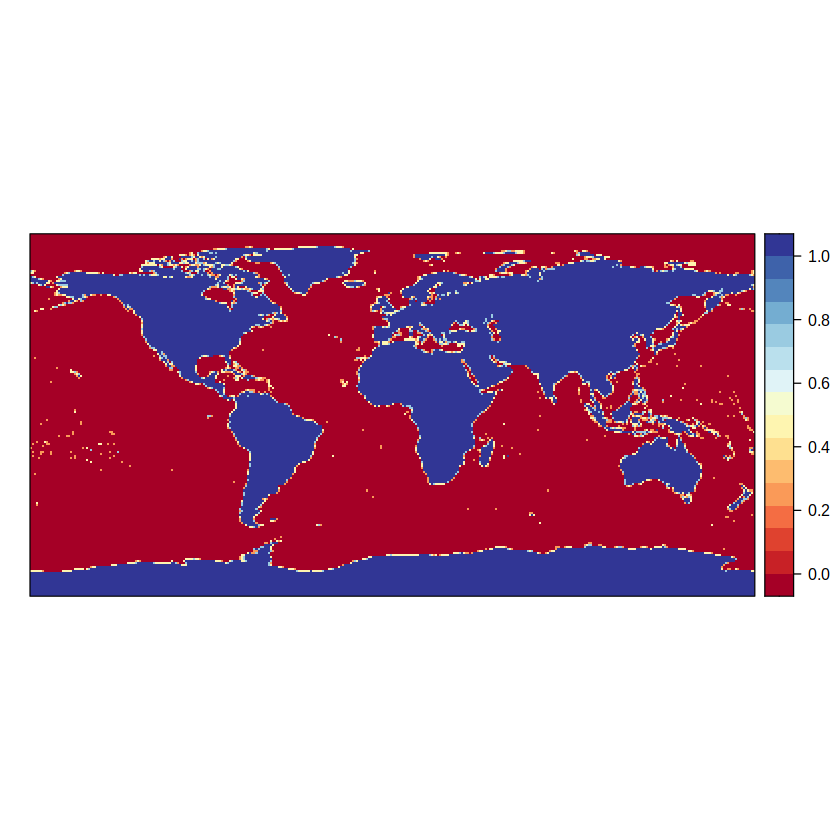
Load model data#
For this example we will use the global mean temperature from the CanESM5 model, which is provided at a monthly time resolution in a netCDF file in the auxiliary-material folder. In particular, we focus on the 2000-2010 period, which can be specified with the years argument in the loadGridData function:
# loading global mean temperature
tas <- loadGridData("auxiliary-material/CMIP6Amon_tas_CanESM5_r1i1p1f1_historical_gn_185001-201412.nc",
var = "tas", years = 2000:2010)
Show code cell output
[2023-05-07 17:03:16] Defining geo-location parameters
[2023-05-07 17:03:16] Defining time selection parameters
[2023-05-07 17:03:16] Retrieving data subset ...
[2023-05-07 17:03:16] Done
Let’s plot the climatology for the analyzed period:
# plotting climatology
spatialPlot(climatology(tas), backdrop.theme = "coastline", rev.colors = TRUE)
Show code cell output
[2023-05-07 17:03:16] - Computing climatology...
[2023-05-07 17:03:16] - Done.
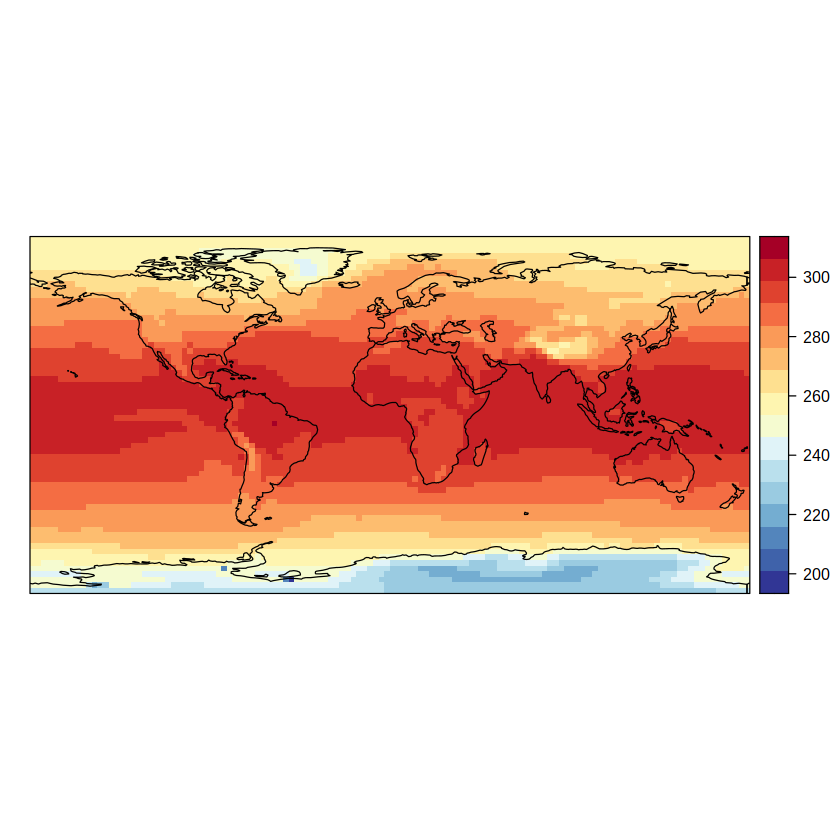
Interpolation#
The global mean temperature we have just loaded comes in the original grid of the CanESM5 model, which has a spatial resolution of about 2.8º:
attributes(getGrid(tas))$resX
attributes(getGrid(tas))$resY
In order to apply the reference 1º land/sea mask to these data and retain only land temperatures, we need first to interpolate the CanESM5 model to the grid of the mask, which can be done with the interpGrid function. We will use in this example bilinear interpolation; however, other interpolation methods are also available in interpGrid.
# Note: This cell may take a while to run
tas.i <- interpGrid(tas, getGrid(mask), method = "bilinear")
Warning message in interpGrid(tas, getGrid(mask), method = "bilinear"):
“The new longitudes are outside the data extent”
Warning message in interpGrid(tas, getGrid(mask), method = "bilinear"):
“The new latitudes are outside the data extent”
[2023-05-07 17:03:17] Performing bilinear interpolation... may take a while
[2023-05-07 17:03:22] Done
attributes(getGrid(tas.i))$resX
attributes(getGrid(tas.i))$resY
Apply the mask to the data#
The binaryGrid function assigns two user-provided values (here NA and 1) to a given C4R grid object according to a threshold and condition. We use it here to obtain a new binary land/sea mask with 1 over land and NA over sea. Note that a threshold of 0.999 (99.9%) land fraction is used to define land/sea grid points.
# binary 1º land/sea mask
land <- binaryGrid(mask, condition = "GT", threshold = 0.999, values = c(NA, 1))
spatialPlot(land)
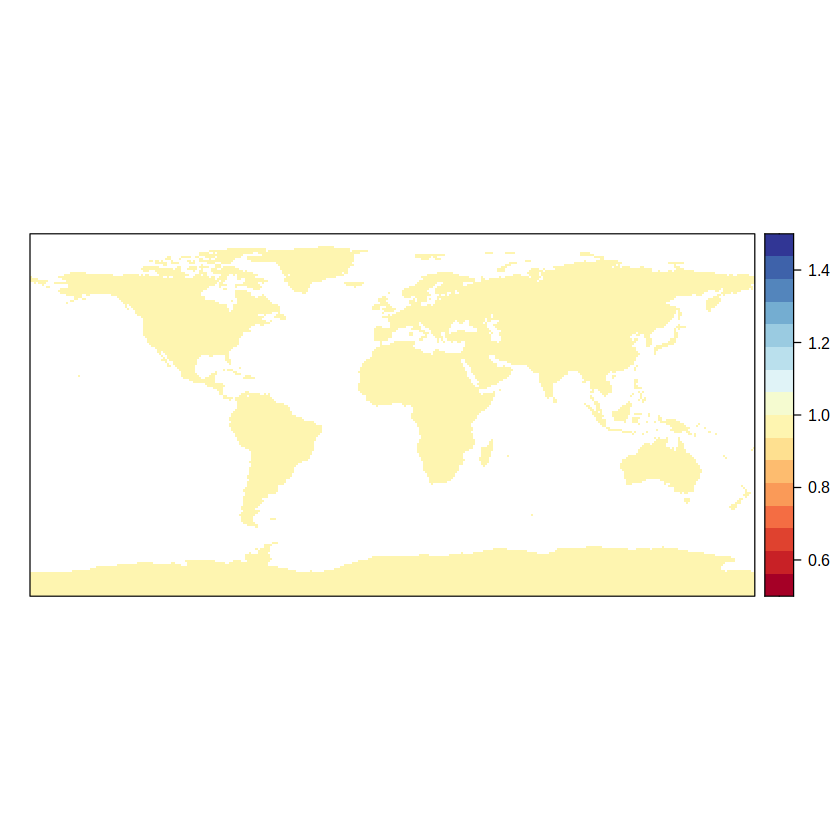
In order to apply this binary mask to our temperature data, we need that both C4R grid objects have the same dimensions. Therefore, we resize the binary mask to match the time dimension of tas.i:
masktimes <- rep(list(land), getShape(tas.i, "time"))
mask2apply <- bindGrid(masktimes, dimension = "time")
Warning message in value[[3L]](cond):
“time dimension could not be sorted!”
At this point, we can already use the gridArithmetics function to multiply the binary land/sea mask and the temperature data, making NA over sea in the latter.
tas.i.land <- gridArithmetics(tas.i, mask2apply, operator = "*")
# final land-only temperature data
spatialPlot(climatology(tas.i.land), rev.colors = TRUE)
[2023-05-07 17:03:25] - Computing climatology...
[2023-05-07 17:03:25] - Done.
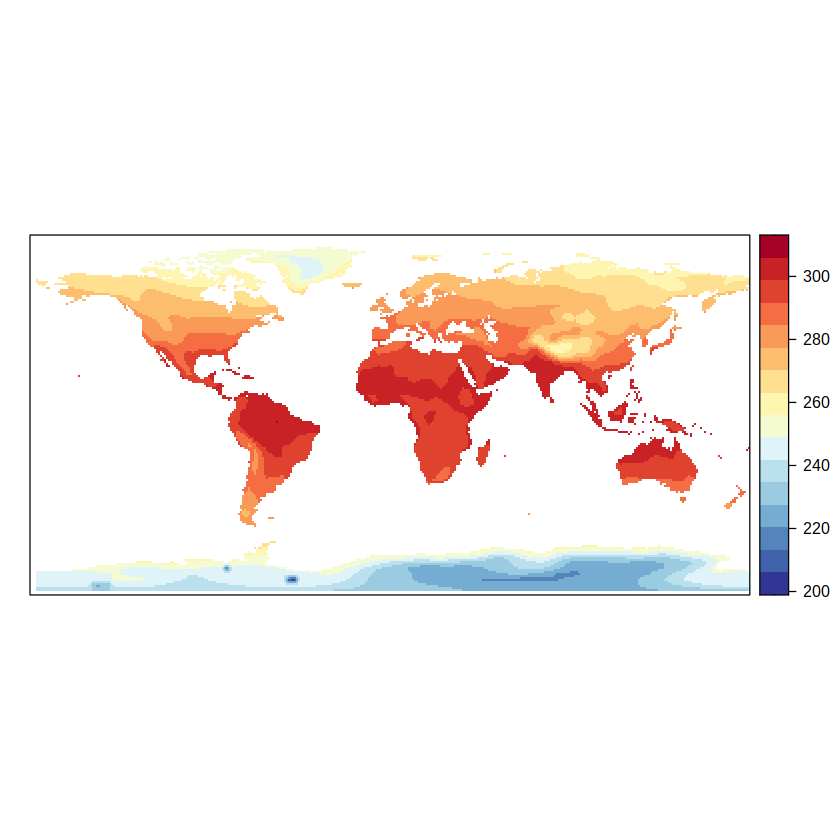
Masked vs. non masked time-series#
Next we compare the monthly time-series of mean temperature, spatially averaged over the entire globe (non masked: tas.i) and only over land regions (masked: tas.i.land):
# monthly time-series (in K)
temporalPlot(tas.i, tas.i.land, x.axis = "index")
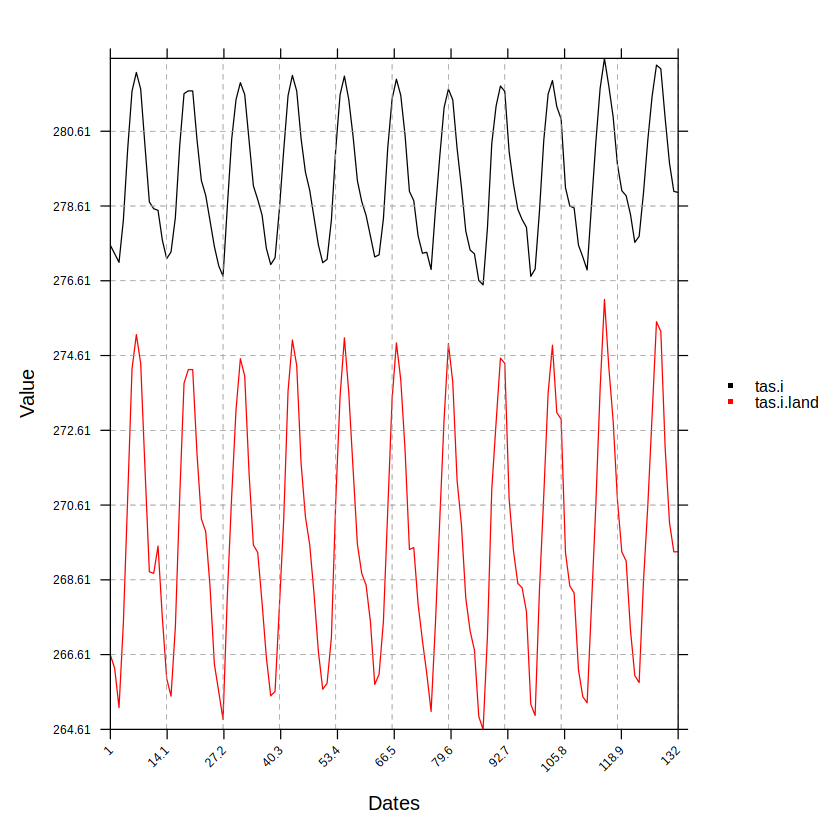
Note that temperature is in K units. The udConvertGrid function from the convertR package allows for easily passing from K to Celsius degrees:
# monthly time-series (in Celsius degrees)
tas.i.degC <- udConvertGrid(tas.i, new.units = "degC")
tas.i.land.degC <- udConvertGrid(tas.i.land, new.units = "degC")
temporalPlot(tas.i.degC, tas.i.land.degC, x.axis = "index")
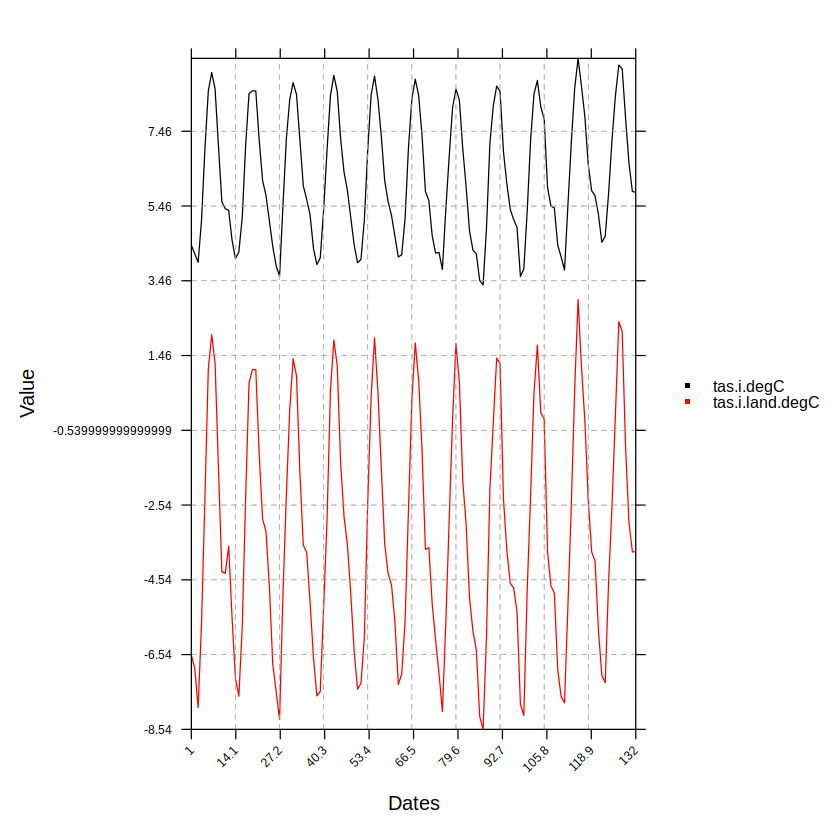
Session info#
sessionInfo()
Show code cell output
R version 3.6.3 (2020-02-29)
Platform: x86_64-conda-linux-gnu (64-bit)
Running under: Fedora Linux 38 (Workstation Edition)
Matrix products: default
BLAS/LAPACK: /home/phanaur/mambaforge/envs/tfg/lib/libopenblasp-r0.3.21.so
locale:
[1] LC_CTYPE=es_ES.UTF-8 LC_NUMERIC=C
[3] LC_TIME=es_ES.UTF-8 LC_COLLATE=es_ES.UTF-8
[5] LC_MONETARY=es_ES.UTF-8 LC_MESSAGES=es_ES.UTF-8
[7] LC_PAPER=es_ES.UTF-8 LC_NAME=es_ES.UTF-8
[9] LC_ADDRESS=es_ES.UTF-8 LC_TELEPHONE=es_ES.UTF-8
[11] LC_MEASUREMENT=es_ES.UTF-8 LC_IDENTIFICATION=es_ES.UTF-8
attached base packages:
[1] stats graphics grDevices utils datasets methods base
other attached packages:
[1] convertR_0.2.0 udunits2_0.13 visualizeR_1.6.1
[4] transformeR_2.1.3 loadeR_1.7.1 climate4R.UDG_0.2.3
[7] loadeR.java_1.1.1 rJava_1.0-4
loaded via a namespace (and not attached):
[1] viridis_0.6.1 maps_3.3.0 jsonlite_1.7.2
[4] viridisLite_0.4.0 SpecsVerification_0.5-3 dotCall64_1.0-1
[7] kohonen_3.0.10 sm_2.2-5.6 sp_1.4-5
[10] latticeExtra_0.6-29 pillar_1.6.1 lattice_0.20-44
[13] glue_1.4.2 RcppEigen_0.3.3.9.1 uuid_0.1-4
[16] digest_0.6.27 RColorBrewer_1.1-2 colorspace_2.0-1
[19] htmltools_0.5.1.1 Matrix_1.3-3 pkgconfig_2.0.3
[22] padr_0.5.3 purrr_0.3.4 scales_1.1.1
[25] jpeg_0.1-8.1 CircStats_0.2-6 dtw_1.22-3
[28] tibble_3.1.2 proxy_0.4-25 generics_0.1.0
[31] ggplot2_3.3.3 ellipsis_0.3.2 repr_1.1.3
[34] verification_1.42 pbapply_1.4-3 magrittr_2.0.1
[37] crayon_1.4.1 easyVerification_0.4.4 evaluate_0.14
[40] fansi_0.4.2 MASS_7.3-54 tools_3.6.3
[43] data.table_1.14.0 lifecycle_1.0.0 munsell_0.5.0
[46] akima_0.6-2.1 compiler_3.6.3 mapplots_1.5.1
[49] rlang_0.4.11 grid_3.6.3 RCurl_1.98-1.3
[52] pbdZMQ_0.3-5 IRkernel_1.2 spam_2.6-0
[55] bitops_1.0-7 tcltk_3.6.3 base64enc_0.1-3
[58] boot_1.3-28 vioplot_0.3.6 gtable_0.3.0
[61] abind_1.4-5 R6_2.5.0 gridExtra_2.3
[64] zoo_1.8-9 dplyr_1.0.6 utf8_1.2.1
[67] parallel_3.6.3 IRdisplay_1.0 Rcpp_1.0.6
[70] fields_12.3 vctrs_0.3.8 png_0.1-7
[73] tidyselect_1.1.1
References#
- Pac
An R package to visualize and communicate uncertainty in seasonal climate prediction - ScienceDirect. https://doi.org/10.1016/j.envsoft.2017.09.008.

